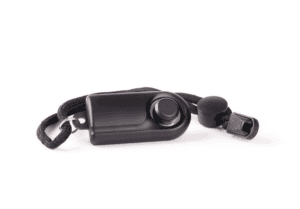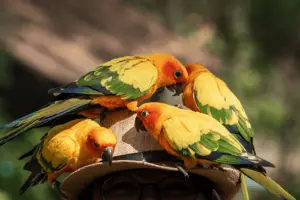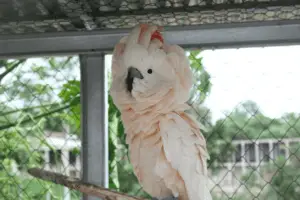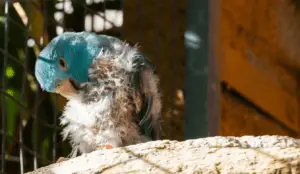The genus Agapornis represents a unique group of small-sized African parrots that make great pets. They may not be great talkers, but they can mimic the human sound and many other sounds. Therefore, if you’re interested in adding one or a pair of lovebirds to your family, you may be wondering about the lifespan of these beautiful birds.
How long will you have fun with your beautiful companion? And what can you do to improve the lifespan of your lovely pair of lovebirds? After all, there are lots of factors influencing the lifespan of your lovebirds.
The lifespan of the lovebird varies with species and whether it’s in captivity or the wild. In the wild, they can live for a maximum of 12 years if lucky or less than five if unlucky. But in captivity, they are known for living for between 10 to 25 years. Some lovebirds have lived for over three decades.
It’s known that birds tend to live longer if well-taken care of in captivity than in the wild. So in this article, we’ll elaborate more on the lifespan of the different lovebird species. We’ll also focus on what we can do to improve the lifespan of our lovebirds. So let’s dive right in.
The Lifespan Of Lovebirds In The Wild
Generally, ornithologists believe that lovebirds’ average lifespan in captivity is longer than in the wild. There are 9 African parrot species with different life expectancies in captivity and the wild. Unfortunately, researchers have not studied the lifespan of wild lovebirds as extensively as that of budgies. But in captivity, lovebirds have a lifespan of 10 to 12 years under favorable conditions.
Unfortunately, some are unlucky and tend to live for less than five years. After all, life in the wild is challenging, primarily since they inhabit harsh African conditions, and most chicks rarely make it to adulthood. Some of the leading causes of short lifespans in lovebirds include:
Diminishing Source Of Water
Lovebirds love water; it is part of their diet; therefore, they need it to survive. And during the dry seasons, they have congregated in huge flocks of over 800. Lack of water can result in the demise of these birds, especially while young.
Lack Of Food
In the wild, these birds are ground-level feeders consuming grass seeds. They can also consume insect larvae and vegetable matter. In the field, lovebirds can also consume millet, sorghum, and corn, but drought can make this impossible, resulting in a declining number of lovebirds.
Poaching
Since people discovered these birds, they have been poaching and exporting them for monetary purposes. Regrettably, harsh conditions usually lead to the demise of some of these birds during their export. Therefore, most of them die even before reaching their destination due to:
- Lack of food,
- Lack of water
- Harsh conditions.
The illegal capture of wild lovebirds for trading is a severe and persistent issue that has forced the United Nations to declare some of them endangered. Therefore, purchasing a lovebird from the breeder, not the poached options, is always a good idea.
Remember, taming a parrot from the wild can be quite challenging, and you may surrender it to the animal shelter. Or it may end up passing away due to stress in captivity.
Predation
The leading predators of lovebirds are the Lanner falcons. The Lanner Falcons are great hunters with a high success rate. They’re known for attacking their prey from aerial attacks and a fast, low flight. Their unique hunting technique leaves the lovebirds with little chance of escaping.
The Lifespan Of Lovebirds In Captivity

Before we talk about the lifespan of lovebirds in captivity, we need to understand that their lifespan will depend entirely on us. Irrespective of how long we expect our pets to live, their lifespan depends mainly on our care.
Therefore, if you want your lovebirds to live for almost three decades, you should research their care more.
Lovebirds living in captivity tend to live longer than their wild counterparts. Here is why:
- They have someone who is constantly caring for them
- They live in a stress-free environment.
- A balanced diet
In rare cases, they have been known to live for over 25 years, with some living for over three decades. Unfortunately, some have been unlucky to live for only a decade because of poor diet, accidents, and harsh conditions.
The Lifespan Of The 9 Lovebirds By Species
As aforementioned, the lifespan of lovebirds in captivity varies with species. Some lovebirds can live for over three decades, while others live for less than a decade. For more details on their lifespan per species, please read on.
- Masked Lovebird
The Agapornis personatus, also known as masked or yellow-collared lovebirds, are beautiful eyering lovebirds that can attain a maximum length of 5.5 inches. These birds are known for living for 10 to 20 years. The oldest living masked lovebird has lived for over 24 years.
- Fischer’s Lovebirds
Fischer’s lovebirds are small-sized Old World parrots named after Gustav Fischer, who discovered it. Considered the most gentle lovebirds, they can live for 12 to 15 years. But some have lived for over 20 years in captivity.
- Peach-Faced Lovebirds
The peach-faced lovebird, also called the Rosy-faced lovebird, is a unique eyering lovebird that can live for 15 to 25 years. These lovebirds are loved for their sleeping positions, including sitting side-by-side with their faces turned to each other.
- Red-Faced Lovebirds
Sometimes referred to as the red-headed lovebird, Carl Linnaeus described it in 1758. This lovebird has listed a maximum of about 19 years, but it can live even longer with proper care.
- Lilian’s Lovebird
Unlike most lovebirds, breeding this species in captivity is difficult and uncommon. Unfortunately, loneliness is the primary cause of their death. These birds are known for living for between 10 and 12 years; luckily, they mate for life. They’re considered “near threatened.”
- Black Cheeked Lovebird
Black-cheeked species are endemic to the southern parts of Zambia, where their population is reducing quickly thanks to habitat loss. Fortunately, in captivity, they are known for living for an average of 13 years.
- Black-Collared Lovebirds
Africa is home to several parrot species, but the rarest parrots in captivity are the black-collared lovebirds. Luckily, the parrot lovers who have managed to keep the black-collared lovebirds claim they can live for an average of between 10 and 15 years.
- Black Winged Lovebird
The Black-winged lovebird is the biggest lovebird species available that can attain a maximum of 6.5 inches. Native to Ethiopia and Eritrea, this species is relatively uncommon as pets, whose average lifespan is 15.83 years.
- Grey-Headed Lovebird
Lastly, the Madagascar lovebird, also known as the Grey-headed lovebird. This species gets its name from its place of origin, Madagascar Island. And in captivity, they have a lifespan of about 16.01 years.
The Lifespan Of Lovebirds: What Affects It?

After discussing the expected lifespan of these parrots, the next step is discussing what factors affect their lifespan. Remember, the lifespan of your parrot is partly in your hands; after all, there are some factors that you can control.
Don’t get me wrong, you can’t control many things, like illnesses, but how you take care of your pet matters a lot. So here are a few things that can affect the lifespan of your pet:
Diet
One crucial thing that affects your bird’s general health is its diet. Generally, the food that you give your bird will affect its health. Therefore, a little knowledge of what’s good for your bird’s health is lacking among lovebird owners.
After all, it’s easy for anyone to pick a bag of seed mix, pour it into their bowl, and assume that they are well-fed.
Unfortunately, seeds alone are not enough; they’re too fatty and don’t have everything your pet needs. In captivity, your pet won’t get enough exercise; therefore, it requires very low-calorie food like lettuce. And too many seeds can result in obesity.
Therefore, a seed mix can be in your pet’s diet, but it should never be your bird’s only food. The lovebirds consume any seed in the wild, but they also eat fruits, sprouts, and berries. In the wild, its typical essential diet includes nuts, grains, and seeds, which you can supplement with organic/bio and natural pellets.
Therefore, you should try and mimic what they eat in the wild, which means feeding them a wide range of foods, including the following:
- Regular seeds
- High-quality pellets as the base food
- Some fresh veggies, including zucchini, carrots, and peppers
- Regular seeds
- Fresh fruits like mangoes, pears, apples, and berries.
- Unsalted cooked grain like pasta and rice
- Wild herbs, boiled eggs, and weeds can also come in handy.
Care
Other than a varied and proper diet, numerous other factors can play a significant role in the lifespan of your lovebirds. Everything that you do while taking care of the lovebirds matters a lot, so here are a few tips that can improve the lifespan of your lovebirds:
The cage size and flying time: the available lovebird cages are pretty small, so they won’t get free flying time and space while in their cages. Unfortunately, fewer workouts mean obesity-like problems. Therefore, you must provide them with many parrot toys to keep them busy inside their cage.
Safety first: generally, for every pet you keep, its safety must always come first. Therefore, you should use safe toys, but most importantly, bird-proof the house before letting your bird fly around.
And don’t let your lovebirds interact with the other pets in the house while new. It can be aggressive and may get injured by some huge birds in the aviary.
Air quality: Lovebirds have an extremely sensitive respiratory system, like all birds. Therefore, you should keep the air in their lungs natural, which means no perfumes or cigarette smoke. Keep the room free of candles and Teflon pan fumes.
Emergencies: you should learn more about the most common signs of illnesses affecting lovebirds. Knowing these symptoms will help you spot an emergency and take your bird to the vet on time.
Stress is a common problem among lovebirds, particularly Lilian’s lovebirds, known for dying of loneliness. Stressed lovebirds can pass away prematurely; therefore, you should avoid spooking your birds. But make sure you give it more social contact without rough handling to prevent loneliness.
How Long Can A Lovebird Live Without Eating?

Every bird, both captive and wild lovebirds, must drink and eat to remain healthy. Plus, they can become easily dehydrated; therefore, you must provide clean water.
Unfortunately, if your lovebird doesn’t eat for over 48 hours, its health will decline quickly. So if you suddenly notice your lovebird has stopped eating, contact an avian veterinarian. It may be stressed or have health issues affecting its appetite.
Conclusion
People associate lovebirds with Valentine’s Day and keep them in pairs. Therefore, lovebird owners are always looking for ways to improve the lifespan of their lovebirds. Lovebirds have been known for living for up to a quarter of a century in captivity. On the other hand, the wild ones can attain a maximum of 12 years.
Some species, like the peach-faced and masked lovebirds, can live for over two decades. Others, like Lilian’s lovebird, black-cheeked and black-collared lovebirds, can live for a decade. They can live for over two decades with proper care, diet, and excellent health.
- Wikipedia contributor Lanner Falcon,https://en.wikipedia.org/wiki/Lanner_falcon#Hunting/ Accessed April 20, 2023
- Wikipedia contributor, Yellow-collared lovebird,https://en.wikipedia.org/wiki/Yellow-collared_lovebird/ Accessed April 20, 2023
- YouTube contributor, Fischer’s Lovebird,https://www.youtube.com/watch?v=t2_tc3LG7m4/ Accessed April 20, 2023
- Wikipedia contributor, Rosy-faced lovebird,https://en.wikipedia.org/wiki/Rosy-faced_lovebird/ Accessed April 20, 2023
- Wikipedia contributor, Red-headed lovebird,https://en.wikipedia.org/wiki/Red-headed_lovebird/ Accessed April 20, 2023
- Wikipedia contributor, Lilian’s Lovebird,https://en.wikipedia.org/wiki/Lilian%27s_lovebird/ Accessed April 20, 2023
- Wikipedia contributor, lovebird,https://en.wikipedia.org/wiki/Lovebird/ Accessed April 20, 2023










